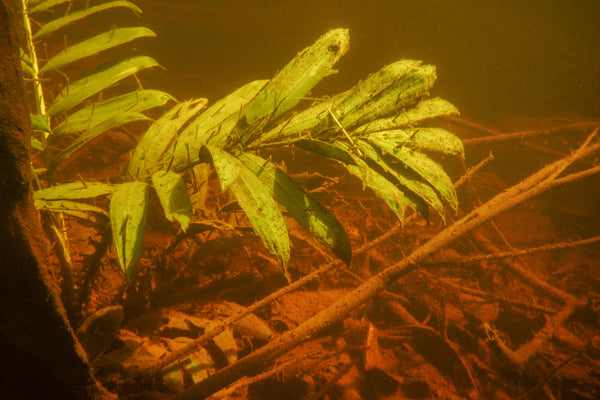- Continue Shopping
- Your Cart is Empty
"...They just started...spawning!"
It happened yet again...a breathless phone call from a customer who recently switched over to a botanical-style, blackwater aquarium, only to have her little Boraras, which she'd had for over a year, suddenly start spawning!
Cool!
Now sure, it could just have been that they finally were of spawning age, or that the temperature in her tank changed one night, or...and number of a dozen possible factors. However, I hear these stories from hobbyists fairy often.
Actually, all the time.
We're seeing more and more in botanical-stye, blackwater aquariums are reports of "spontaneous" spawnings of all sorts of different fishes associated with these types of conditions.

Often, it's fishes that the aquarist had for a while, perhaps with little effort put into spawning them, and then it just sort of "happened." For others, it is perhaps expected- maybe the ultimate goal as it relates to said species...but was just taking a long time!
The "common denominator" in all of the reports we receive are that the fishes are displaying better color, vigor, and overall health after being recently exposed to the more "physiologically appropriate" conditions of a blackwater aquarium. Now, this is by no means us stating that blackwater tanks are somehow magical, and possess the ability to make every fish magically thrive and spawn.
Rather, it's more of an affirmation that fishes from specialized environments- even those which might be several generations captive-bred, can always benefit from being "re-patriated" to the conditions under which they have evolved for eons.

I know that there are those who will adamantly state that this is not necessary or true, but I just have this really hard time accepting the argument that fishes from say, soft, acidic blackwater are somehow "better off" in hard, alkaline "tap water" conniptions...after only a few generations in captivity. Have we somehow "changed" the physiology or physiological needs of the fish, which evolved over millions of years, in a few decades?

I'm not buying that argument!
"Acclimated" to the water parameters that work for US? Sure...However, "changed" their physiological requirements for certain conditions?
Nah. Not buying that.
Now, I could be totally wrong, but I'm not listening anyways...lol (I'm not irrationally stubborn or anything...LOL)
Look, this L.A. boy, who's lived all of his life in warm temps CAN adapt to living in frigid Antartica, if I'm given the proper clothes, housing, etc. I could even start a family there. Yet, does this mean that we've somehow evolved to thrive in these conditions?

Seriously, I think there is a lot to be said for the potential benefits of humic substances for fishes- and indeed, much research has been done in this area already by science. Still, much is yet to be fully understood, but suffice it to say, there are a variety of health benefits ascribed to humic substances found in blackwater habitats, and the "superficial", yet numerous observations we've made thus far seem to confirm this!

What advantages do they give us when we're trying to breed fishes from these habitats?
We're still learning this stuff, aren't we?

Now, I am equally fascinated by the possible benefits of these conditions for fry. In other words, not only the chemical conditions (i.e; pH, levels of tannins/humic substances, etc.), but the possibility that the biofilms which botanicals and leaves "recruit" will serve as an excellent natural source of food- supplemental or otherwise- for many fish fry. Biofilms and the organisms which are found with them are consumed by a number of species as adults, so it goes without saying that, if they're available to fry, they might also be a possible source of nutrition.
Which leads me to wonder...
Could a botanically-"stocked" aquarium, complete with perhaps a deep leaf litter bed and/or lots of botanicals, "doing their thing", serve as a sort of "nursery" for fry of fishes which are accustomed to blackwater conditions?

I think so!
So, perhaps a version of the fry-rearing tank that's a bit more than the typical bare-bottomed, hyper-maintained nursery tanks we tend to use so often- might be a good thing to experiment with? I mean, sure, for commercial breeding, it probably would be a challenge...but for the hobbyist working with just a few species...could this be a great way to provide some supplemental/primary feeding? A sort of "botanical refugium" for fry?

I think there is precedent.
I mean, what hobbyist hasn't had one of those planted "jungle" tanks over the years, where you'd just sort of "stumble" on fry from time to time in the "canopy" of plants? I mean, same idea, right? Natural foods...and protection?

I think that we might see some of this as more and more hobbyists experiment with botanical-style brackish tanks, too! A lot of potential discoveries- even breakthroughs- are possible!
None of this stuff is completely mind-blowingly revolutionary. But it is evolutionary...a sort of possible progression in thinking. It's not really "rocket science" ("Filll tank with water. Add leaves and let them decompose. Add fish fry.") Much research needs to be done.
Who's up for it?
Because I think that there is a lot to it when we hear those reports that, "...They just started...spawning!"
Stay excited. Stay engaged. Stay creative. Stay thoughtful. Stay progressive...
And Stay Wet.
Scott Fellaman
Tannin Aquatics










Scott Fellman
Author